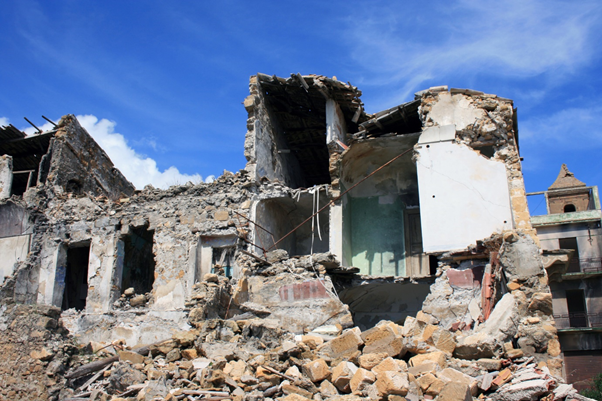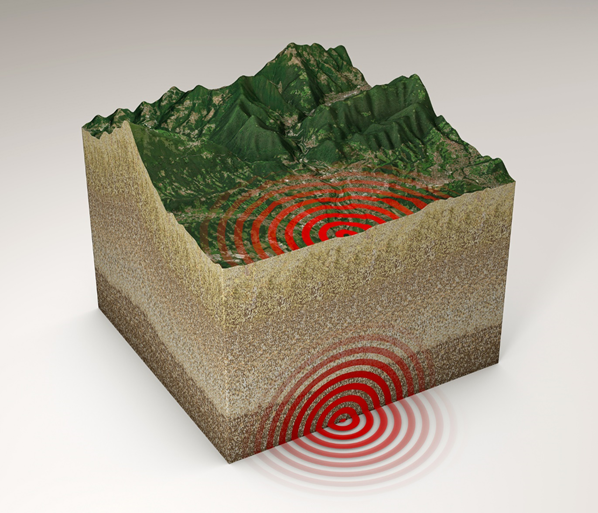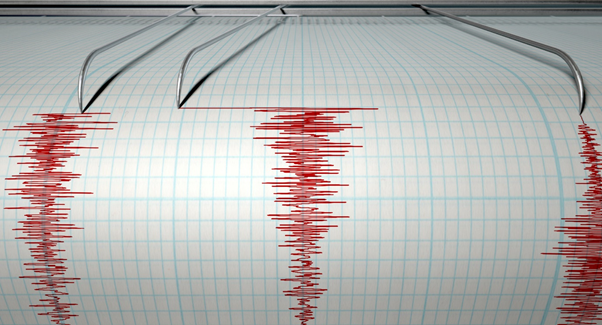What is an Earthquake?
An earthquake is the process of intense ground shaking due to the sudden release of energy. The release of energy results in waves that radiate outward from the epicentre. When the stress in the crust exceeds the strength of rock, the rocks break along the line of weakness. Hypocenter or focus is the point from where an earthquake originates, and it may be located several kilometres deep into the earth. The point that is present vertically above the hypocenter is known as the epicentre of the earthquake.
Earthquake is a type of deadly natural hazard. Hundreds of earthquakes occur each year and cause substantial damage to human lives and the economy.

Source: © Antonello84 | Megapixl.com
What are the causes of earthquakes?
Earth comprises of four major layers – the inner core, outer core, mantle and the crust. The crust is the topmost layer of the earth that covers the mantle and acts as skin for the planet. The mantle is a semi-solid and dense layer of rocks above which the crustal plates float. Crustal plates are huge pieces of crustal rocks which are also known as tectonic plates.
The lower density of crustal rocks and higher density of semi-solid mantle helps the tectonic plates to float above the mantle. These plates don't rest in a single place; rather, they move depending on the movement of the mantle.

Source: © Vampy1 | Megapixl.com
Most of the earthquakes take place when one plate collides with another plate. The denser plate subducts under the plate having relatively lower density. During subduction edge of one plate stuck with another due to friction. As soon as the stress on the tectonic plate’s edge overcomes the friction, energy is released in the form of an earthquake to release seismic waves in the outward direction through the earth’s crust.
Why do we feel shocks during an earthquake?
The sudden release of energy in the form of waves after the breakdown of the plate is the primary reason for feeling shocks when an earthquake comes. The released energy radiates in the outward direction, creating disturbances in the form of tremors while travelling. The outward radiating energy in the form of seismic waves shakes the earth as soon as they reach the earth's surface, shaking everything, including houses, ground, buildings to shake.
What are the type of waves generated during an earthquake?
Two types of waves generated during an earthquake, viz- are body waves and surface waves. Body waves travel through the earth's body and get reflected or transmitted at the interfaces as the density of the medium changes. There is two main type of body waves - P-wave and S-wave that are generated during an earthquake. The p wave is a longitudinal wave, and the S wave is a transverse wave.
The surface waves are the other form of waves originating during an earthquake and guided along the earth's surface. Rayleigh and Love are the two type of surface wave. Rayleigh is responsible for ground rolls and creates maximum destruction during an earthquake.
Summary
- An earthquake is the process of intense ground shaking due to the sudden release of energy.
- Most of the earthquakes take place near the plate boundaries when one plate collides with another plate.
- Two types of waves are generated during an earthquake, body waves and surface waves.
Frequently Asked Questions (FAQs)
How do scientists record earthquake?

Source: © Albund | Megapixl.com
Scientists use seismograph for recording seismic waves to create seismograms. The basic design of the seismograph includes a fixed base that sets into the ground and a hanging weight attached to a spring system that hangs free. During an earthquake, the base of the seismograph vibrates, whereas the hanging weight remains relatively stable. The shocks are absorbed by the spring attached to the hanging weight. The difference between the position of the moving part and the stable part of the seismograph is recorded, which gives information about the size of the earthquake.
How can we measure the scale of an earthquake?
The size of an earthquake depends on the amount of energy released at the hypocenter. Seismographs record the amount of the size of an earthquake. As discussed earlier, the difference between the position of the moving part and the stable part of the seismograph tells the size of an earthquake. The recorder records and plots a wiggly trace of the difference. The larger the amplitude of wiggly trace, the higher is the size of an earthquake and vice versa. The size of the earthquake is known as magnitude.
How do earthquakes affect buildings?
The damage to buildings caused by the earthquakes is dependent on the magnitude of the earthquake and the local geology of the area over which the buildings are constructed. The buildings present over the soft grounds that consists of flood plains, former landfills, or reclaimed lands amplifies the effects of an earthquake vibration rather than hard rocks. Hard rocks limit the effects of an earthquake by reducing ground shaking and damage to buildings.
The impact of the earthquake also depends on the construction and design of buildings. A poorly constructed building where walls and slab are not tied properly are more vulnerable to the damage.
Which are the most active regions?
The circum-Pacific seismic belt along the rim of the Pacific Ocean is the world's greatest earthquake-prone zone that accounts for around 81% of the total earthquake of the world. The second most prone zone for earthquakes is the Alpine earthquake belt that lies from Java to Sumatra. The regions account for almost 17% of the world's total earthquakes. Mid Atlantic ridge is the third most prone earthquake zone of the earth. The region is submerged below the ocean, and it is formed due to a divergent plate boundary. The region experienced several earthquakes of 6.9 magnitudes.
 Please wait processing your request...
Please wait processing your request...